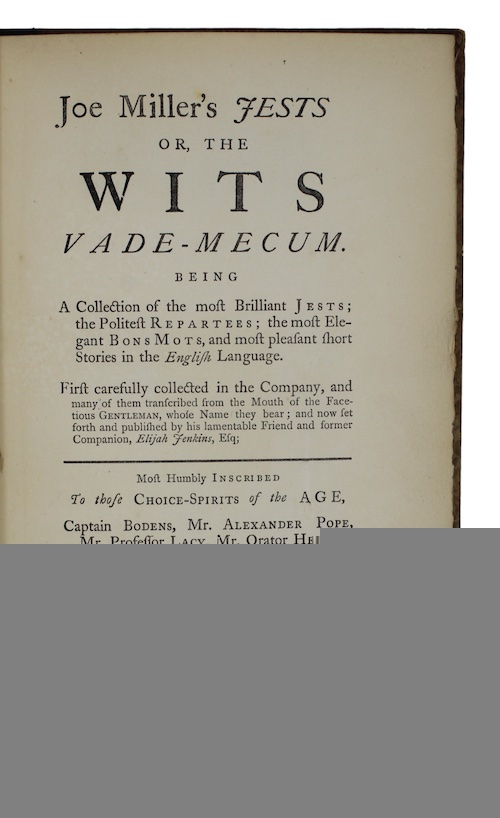
MILLER, Joe
Joe Miller’s jests or, the wits vade-mecum.
[s.n.], [s.d., c. 1860], [s.i.]: 1860
- $98
[2], 70pp. Uncut in contemporary navy morocco-backed decorated paper boards, ruled and lettered in gilt to spine. Extremities rubbed, marked, and browned, loss to head of spine. Endpapers browned, else internally clean and crisp. Red morocco bookplate of W. A. Foyle to FEP. A well-executed facsimile of the first edition of one of the most influential jest books of the eighteenth-century. The eponymous Joe Miller (1684-1738), English actor, first became associated with anthologies of epigrams with the publication of Joe Miller's Jests: or, the wits vade-mecum (London, 1739), compiled by John Mottley (1692-1750) under the pseudonym of Elijah Jenkins. The immense popularity of the work led to the emergence of many imitators throughout the latter half of the eighteenth-century and the continued use of Miller's name regardless of whether they possessed any actual association to the man. William Alfred Westropp Foyle (1885-1963), bookseller, co-founder of the eponymous bookshop on Charing Cross Road. Following his purchase of the former medieval monastery of Beeleigh Abbey in 1943, Foyle built an extensive personal library. In July 2000, following the death of his daughter and successor Christina, the library was dispersed at Christie's over three days, at the time being the most valuable English private library ever to be offered in Britain or on the Continent. Those books that remained with the family were sold by Dominic Winter Auctioneers in 2023 following the death of Foyle's grandson Christopher. Size: 8vo
More from Antiquates Ltd

The Silver Spoon
GALSWORTHY, John viii, 323pp. Original publisher's red cloth. A little bumped and stained, with the spine notably sunned. Inked ownership inscription of Laurence Olivier to the FFEP, dated 1928. John Galsworthy (1867-1933) was a Nobel Prize winning English novelist and playwright. Best remembered now for The Forsyte Saga, several of Galsworthy's short stories and plays were adapted for the screen - including his own adapted stage play The First and The Last (short story 1917, stage play 1919), which went on to be released for the big screen by Columbia Pictures as 21 Days, starring Laurence Olivier alongside Vivien Leigh, in 1940. From the library of Laurence Olivier, acquired during his illustrious, industrious, and enduring career as one of the most important figures of stage and screen in the 20th century. Size: 8vo- $163
- $163
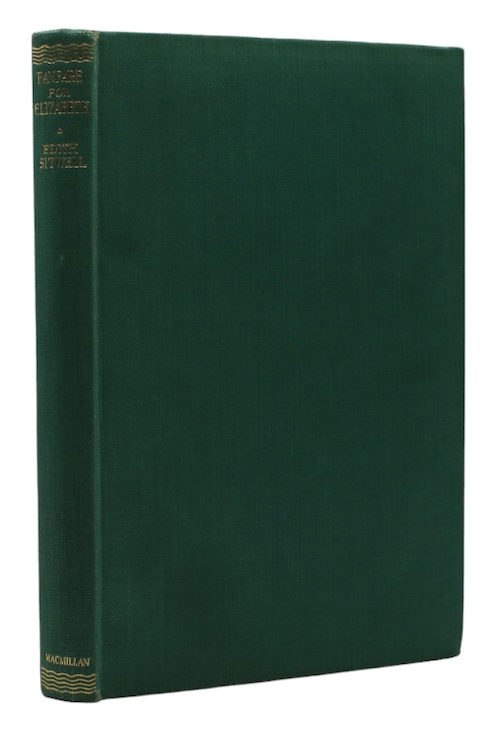
Fanfare for elizabeth
SITWELL, Edith viii, 202pp. With a frontispiece and three further plates. Original publisher's green cloth, lettered in gilt. Without dustwrapper. A little bumped and marked. Lightly foxed throughout with a little loss to front pastedown. From the library of Laurence Olivier - without any indication of such - acquired during his illustrious, industrious, and enduring career as one of the most important figures of stage and screen in the 20th century. Size: 8vo- $65
- $65
The Impossible Theatre
EVERSHED-MARTIN, Leslie xix, 144pp. With 17 leaves of photographs. Original publisher's cream cloth, red title label to spine, with original publisher's dustwrapper. Extremities stained and marked, significant loss to dustwrapper. Internally bright and clean. Inscribed by the author to title page: 'For Larry and Joan, In gratitude for all that you gave us in inspired direction and splendid friendship'. This specially bound edition was published in a run of 250 copies numbered and signed by the author, this being no. 9. Leslie Evershed-Martin, CBE (1903-1991) was a British theatre impresario, two-time Mayor of Chichester, and in his civilian life, an optician. He was both the founder and chairman of the Chichester Festival Theatre, and appointed Olivier as its first director in 1961. However, to Evershed-Martin's chagrin, Olivier resigned after the first season to take on the role of director of the National Theatre. Their relationship seems to have been somewhat repaired by 1971, with Olivier providing a flattering prologue on the early days of their collaboration. From the library of Laurence Olivier, to whom many of these books were gifted over the length of his illustrious, industrious, and enduring career as one of the most important figures of stage and screen in the 20th century. Size: 8vo- $327
- $327
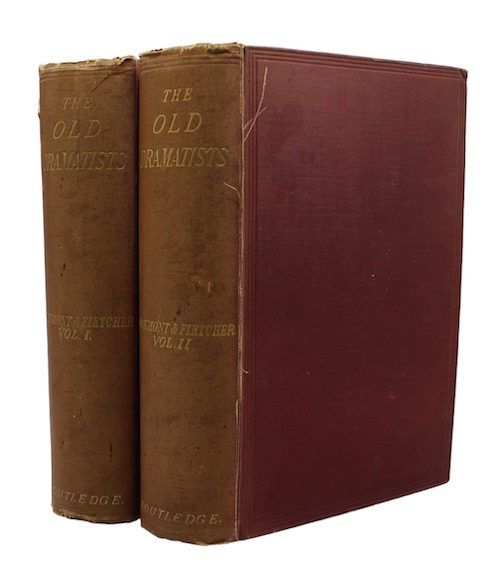
The works of beaumont and fletcher, with an introduction by george darley.
BEAUMONT, Francis, and John FLETCHER In two volumes. lxxii, 645; vii, 720pp. Both volumes with an engraved frontispiece and title page. Original publisher's red cloth, lettered in gilt. Both volumes a trifle shaken, bumped and frayed, spines sunned. Internally bright and clean. A new edition of the complete works ascribed to Fletcher and Beaumont, both in collaboration and individually. The two playwrights were active in the reign of James I (1603-25), and modern scholarship estimates their canon at approximately 55 plays. One of these, The Chances (c. 1617), was chosen by Laurence Olivier to open the Chichester Festival Theatre in 1962, despite neither the original or the 1680 adaptation having been staged much since. It was not well received, and was not revived in the following seasons. From the library of Laurence Olivier - without any indication of such - acquired during his illustrious, industrious, and enduring career as one of the most important figures of stage and screen in the 20th century. Size: Large 8vo- $131
- $131
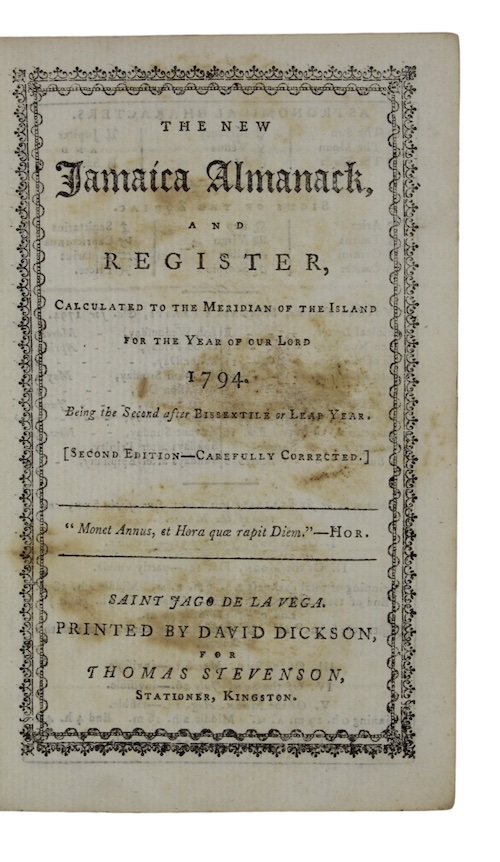
The new Jamaica Almanack, and register, Calculated to the Meridian of the Island for the Year of our Lord 1794. Being the Second after Bissextile or Leap Year. [Second Edition – Carefully Corrected]
[JAMAICA] 146pp, [14]. With two hand-coloured engraved leaves of plates depicting 'Signals for distinguishing the Several Packets on the Falmouth Station' bound in before title. Variously interleaved at front, with numerous blanks at end inserted, some of which removed. Contemporary, perhaps original gilt-tooled wallet-format calf over card boards, the fold-over flap missing, but with an open fore-edge to upper board with marbled paper-lined pocket. Rubbed and marked, with some occasional staining, sometimes rather unsightly, to text, childish pen and pencil trials to endpapers, engraved signals (largely erased), and some blank- interleaving or areas of text. Occasional manuscript correction to text. Bifolium G3-4 detached from the binding. A rare Jamaican-printed almanac - with the original engraved signals leaves apparently issued only in this edition - featuring an early example of West-Indian Hebrew printing. Almanacs were apparently first issued in Jamaica during the 1760s, printed by Weatherby & McCann, Walker & Strupar, Douglass and Aikman, and later Alexander Aikman alone, at Kingston. The rival New Jamaica Almanack and Register first appeared in the same city in 1788, printed by Bennett and Dickson, for the stationer Thomas Stevenson of King Street. From 1791 this same title was printed by David Dickson alone at Spanish Town (Saint Jago de la Vega). This is definitely not the second appearance of a Dickson printed almanac either printed at Kingston or Spanish Town (editions for 1791, 1792 and 1793 are known, for example, with the Saint Jago de la Vega imprint), despite the title designation. In addition to providing a calendar specifically for use in the colony, noting for example the dates of various Jamaican assizes, these eighteenth-century almanacks are perhaps best known for their inclusion of some of the earliest examples of printing with Hebrew type - specifically produced for the use of the largest Jewish community in the Atlantic outside of London - in the Western hemisphere, significantly predating any American-printed Hebrew calendar. This is displayed in this edition as a final calendar leaf headed 'Of Months, Sabbaths, and Holidays, which the Hebrews or Jews observe and keep, for the Years 5554 an 5555 of the Creation'. Whilst much of the remainder of the first half of the volume relates to British government and administration, the first 30pp of the second half includes a description of the geography and history of Jamaica, and excerpts various commercial treaties applicable, including the 'Act for regulating the Commerce with America', and notes the duties due to the Receiver-General for landing traded goods. Rather disturbingly, this includes the government duty of £2 'per head' imposed upon the importers of enslaved Africans. Fully 44 further pages, headed 'Jamaica Lists', relate to the civil administration and military establishments of the colony, including lists of officials and appointees, headed by the then Lt.-Governor Major General Adam Williamson. Included in this section are extensive details on the economic output of the plantations of the island, grouped by parish within different counties, often revealing the extent of enslavement. Thus, St. George is noted as housing '19 Sugar Works, and 5 more settling, 90 other Settlements, 7000 Slaves, and 4500 Cattle', whilst Trewlawny housed '86 Sugar Works, 126 other Settlements, 27000 Slaves, and 15000 Cattle'. Copies of the Dickson-printed almanacks printed during the final decade of the eighteenth- century are known with and without maps. There is none present here, but equally there is no obvious absence of such. However, the only reference we can find to any edition of an almanac with engravings of signals flags, as here, is in the 1794 edition; indeed, the foot of the first of the two engraved leaves notes that it was 'Engraved for the New Jamaica Almanac, 1794'. Given the increasingly visible presence of Royal Naval ships in the West Indies due to action taken against French colonies in the War of the First Coalition, it is entirely possible that the signals were placed in some copies of the 1794 New Jamaican Almanack instead of the map. OCLC locates three copies worldwide (Temple, with a map, and two at Yale, one without a map or signals, wanting pp81-102, and possibly pp.145-6; and another without map but with the signals). ESTC N67930. Size: 12mo in 6s- $8,165
- $8,165

Report from the committee on the commercial state of the west indian colonies
[WEST-INDIES] 85pp, [3]. Docket title to verso of terminal leaf. Apparently unrecorded. [Bound with:] Report from the committee on the distillation of sugar and molasses. [London?] [s.n.], [1808]. 317pp, [1]. [And:] Second report from the committee on the distillation of sugar and molasses. [London?] [s.n.], [1808]. 319-341pp, [5]. Docket title to verso of terminal leaf. [And:] Third report from the committee on the distillation of sugar and molasses. [London?] [s.n.], [1808]. 343-388pp, [2]. Docket title to verso of terminal leaf. [And:] [Drop-head title:] House of assembly, Veneris, 23o die Novembris, 1804. [Report of a committee on the abolition of the slave trade.] [Spainish Town, Jamaica?]. [Alexander Aikin, Jun., Printer to the Honourable Assembly], [1804]. 40pp. With two folding tables. OCLC and COPAC together record copies at only two locations (LoC and Wales). [And:] [Drop-head title:] House of assembly, Veneris, 13o die Novembris, 1807. [Report of a committee to enquire into the consequences of imposing duties on sugar.] [s.i., Jamaica?] [s.n.], [1807]. 8pp. Apparently unrecorded. [And:] [Drop-head title:] At a Meeting of the West India Association of Planters and Merchants in Glasgow, held for the purpose of considering the proper remedies for relief of the West India Colonial Trade, on the 8th January, 1808. [Glasgow], [S. Hunter], [1808]. 2pp, [2]. Docket title to verso of terminal leaf. Apparently unrecorded. [And:] [Drop-head title:] Unto the right honourable, the lords commissioners of his majesty's treasury the memorial of the importers, dealers, and others, interested in the Sale of Rum at the Ports of Clyde. [Glasgow]. [Mennons & Co.], [1804]. 2pp. Single sheet, printed on both sides. Apparently unrecorded. [And:] [Drop-head title:] Sugar trade of great britain, From 1808 to 1821, Collected from returns to the House of Commons, ordered to be printed 19th April, and 28th May, 1821. [Glasgow]. [s.n.], [1821]. Apparently unrecorded. Dimensions 390 x 330 mm. Single leaf broadside, pasted to recto of initial leaf of next bound work: [Accounts relating to sugar.] [London?] [s.n.], [1821]. 7pp, [1]. Docket title to verso of terminal leaf. Folio and quarto. Contemporary gilt-ruled calf, contrasting black morocco lettering-piece. Rubbed and marked, joints starting. Very occasional light spotting. Contemporary inked ownership inscription of James Ewing to FEP, with detailed manuscript notes on British commerce between 1793 and 1827 in his hand beneath. A coherent sammelband of rare and important publications, several unrecorded, relating to British commerce, in particular the sugar trade of the West Indies, from the library of Scottish merchant, plantation owner, slave-holder, and sometime politician James Ewing of Strathleven (1775-1853). Ewing founded the Glasgow-West India merchant firm James Ewing & Co. around 1803. The company imported sugar and cotton and profited from commission. In addition, Ewing exported goods, including textiles and foodstuffs, to slave plantation owners in Jamaica. In 1807, he was one of the leading influences behind the establishment of the Glasgow West India Association, the primary pro-slavery lobbying group outside of London. There is no record of Ewing ever visiting Jamaica, later came to hold significant interests on the island. In 1832 he took ownership of Taylor Caymanas plantation and its enslaved workers in St Catherine. He also held security over those on other plantations. Following the emancipation of enslaved people in British colonies in 1834, Ewing claimed over £9,000 in compensation. The documents collected here are a testament to Ewing's heavy involvement in the sugar trade, his primary source of income in the early nineteenth century, and the profiteering from slavery which would provide the foundation for his expansion into other lucrative enterprises. Of particular importance within this largely commercially orientated volume is a Jamaica- printed report of an 1804 House of Assembly committee on the effects that an abolition of the slave trade would bring, freely admitting that it would be disastrous for the West Indian colonies, and threaten the cultivation of sugar - a development that Ewing would most surely have been fearful of. The highly detailed study includes a wealth of statistical information regarding the economic situation of the West Indies, including two appendixed folding tables, and blames diminishing economic circumstances squarely on 'laws and regulations, withholding from the West- India colonies a necessary supply of labourers, giving undue encouragement to rival settlements, and heaping upon their staples exorbitant and oppressive imposts'. It also reveals the visceral fears held by the representatives of the slave- owning class of Jamaica, in both their future economic prospects and physical safety, suggesting that West Indian developments post- abolition would reveal to its strongest advocates that: 'They will soon see that the situation in which the island is placed invites them to assist the wishes of their friends, before the delusions shall vanish; and, in such circumstances, the struggle will not be long though the catastrophe will be terrible'. The two unrecorded Scottish-printed documents, produced on behalf of merchants there with interest in the West Indies, provide yet further detailed economic analysis of the changing nature of trade between Great Britain and those areas which had long relied so heavily upon the slave trade. As a whole this volumes presents a fascinating insight into the business interests of an important figure in the transatlantic sugar trade in the age of abolition, and as such surely a remarkable research opportunity.- $16,330
- $16,330

Mandoline
BERTHET, Jean 88pp, [4]. Original publisher's printed paper wrappers, all edges untrimmed. Lightly sunned, staining to lower wrapper, along with a corner crease. Inked presentation inscription to half-title: âà Sir Laurence Olivier, Saint James Theater. Hommage de lâauteur.â Loosely inserted is a single-leaf typewritten readerâs report by âK. A.â, dated 1954. The enclosed report tells the story is 'A whimsy comedy' following it's hero 'Mandoline' through four seasons of the year, with each one he entirely changes his personality. The comments surmise 'Light and at times amusing, it would not, I think, translate well'. From the library of Laurence Olivier, to whom many books were gifted over the length of his illustrious, industrious, and enduring career as one of the most important figures of stage and screen in the 20th century. Size: 8vo Limited edition of 1000, this numbered 14.- $65
- $65
[A photograph album including many of India]
[PHOTOGRAPH ALBUM] [31] leaves. 317 mounted photographs. Contemporary gilt-ruled black half-morocco, green buckram boards, later rebacked preserving contemporary backstrip. Rubbed, lower board and four leaves detached. One photograph and one postcard loosely inserted. Inked ownership inscription of Blanche Ferguson to recto of initial leaf. An early twentieth century album of photographs, including close to two hundred taken during a tour of India between November 1927 and February 1928; including views of Bombay, Karachi, Lahore, Delhi, Calcutta, Lucknow, Madras, Burma, and Kandy. Size: Oblong quarto- $588
- $588

Special occasions
TAINSH, William [xii], 113pp, [1]. Original publisher's brown cloth, lettered in black. Extremities a little faded. Internally bright. Presentation inscription to FFEP: 'To Sir Laurence Olivier with my respects and felicitations. William Tainsh'. William Tainsh was an Australian poet and broadcaster, popular predominantly among the Scottish community in Melbourne. This title was likely inscribed during Olivier's tour of Australia with Vivien Leigh and the Old Vic Company. From the library of Laurence Olivier, to whom many books were gifted over the length of his illustrious, industrious, and enduring career as one of the most important figures of stage and screen in the 20th century. Size: 8vo- $65
- $65
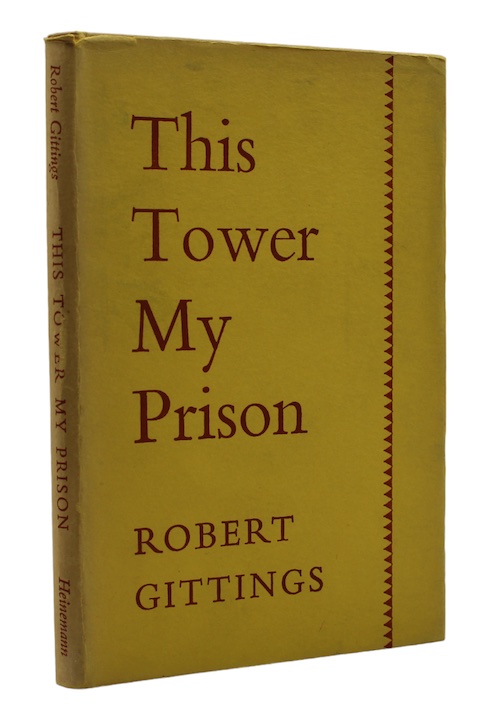
This Tower is My Prison and other poems
GITTINGS, Robert [8], 56pp. Original publisher's canary yellow cloth, lettered in red, with original publisher's dustwrapper. A trifle rubbed and marked, with the top edge of the wrapper bumped. Presentation inscription to FFEP: 'from Robert Gittings to L.O. August 30th, 1962'. Robert Gittings (1911-1992), English writer, biographer, and BBC Radio producer. In 1978, he was awarded the James Tait Black Memorial Prize for his biography The Older Hardy. Wentworth Place was his first major collection of poetry. From the library of Laurence Olivier, to whom many books were gifted over the length of his illustrious, industrious, and enduring career as one of the most important figures of stage and screen in the 20th century. Size: 8vo- $65
- $65
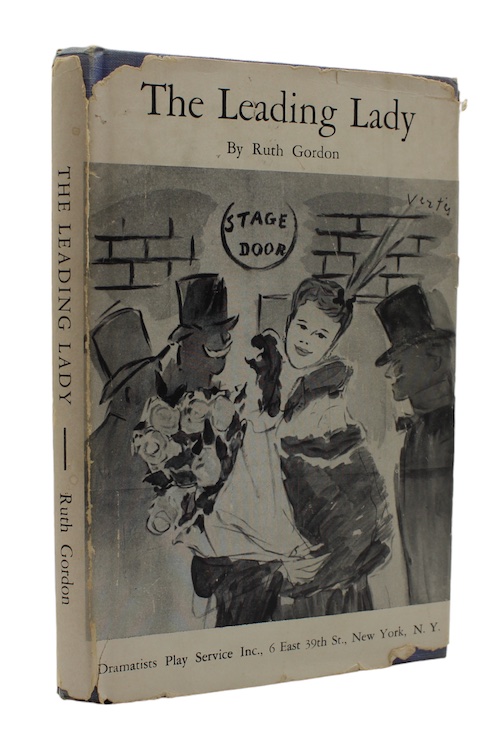
The leading lady: a play in three acts
GORDON, Ruth [vi], 81pp., [1]. With a frontispiece. Original publisher's cornflower cloth, lettered in gilt, with original publisher's pictorial dustwrapper. Cloth a little faded, wrapper chipped with minor losses. Frontispiece detached. Inscribed to FFEP: âFor Larry, with love, Ruth. 4. Aug. '75â. Ruth Gordon (1896-1985) was an Academy-Award winning American actor and writer, who's career spanned from the silent film era to Columbo and Saturday Night Live. In the summer of 1975, Olivier was present in New York working on the Sherlock Holmes film The Seven-Per-Cent Solution in a cameo role as Dr. Moriarty. From the library of Laurence Olivier, to whom many books were gifted over the length of his illustrious, industrious, and enduring career as one of the most important figures of stage and screen in the 20th century. Size: 8vo- $163
- $163
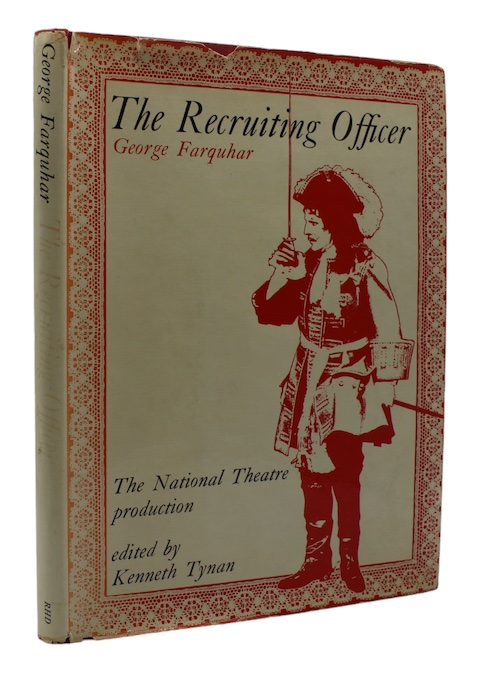
The Recruiting Officer
FARQUHAR, George 144pp. Original publisher's red cloth, lettered in gilt, with original publisher's pictorial dustwrapper. Wrapper a trifle faded with minor losses and fading, unclipped. Bright and clean save a little water damage to the top right of text-block, Inscribed to FFEP: 'To The Boss - With My Best - Ken, 1965'. Kenneth Tynan (1927-1980) was an influential - and groundbreaking - English theatre critic and writer, who rose to prominence during the 'Angry Young Man' movement that promoted theatrical realism. Despite being critical of Olivier's tenure at Chichester Festival Theatre, Tynan nonetheless recommended himself as Literary Director of the National Theatre. Olivier's wife, Joan, had to convince her husband to accept - a decision that would cement both his and Tynan's reputations internationally. This is the first edition of the companion volume to one of Tynan's National productions that starred Olivier, which Tynan explains in the introduction 'is a detailed illustrated account of a production that did for an English classic the kind of service a National Theatre exists to provide â" that of cleaning away the accretions of dust and overprinting with which time has disfigured the textâ. From the library of Laurence Olivier, to whom many books were gifted over the length of his illustrious, industrious, and enduring career as one of the most important figures of stage and screen in the 20th century. Size: Large 8vo- $392
- $392
![[Drop-head title:] Under the patronage of her most gracious majesty](https://rarebookinsider.com/wp-content/uploads/2024/06/31895611012-600x414.jpg)
[Drop-head title:] Under the patronage of her most gracious majesty, his royal highness prince albert, &c. Royal surrey zoological gardens, The summer season at this Favourite place of Fashionable Resort will commence on monday, may 13th, 1850, tuesday, 14th, wednesday, 15th, thursday, 16th and be continued on each of those days throughout the Season. First representation of an entirely new-modelled dioramic picture, representing the passage of the alps by napoleon & his army, the largest picture in the world.
[NAPOLEON] Single leaf broadside. Central old vertical fold, two old horizontal folds. A trifle dampstained. An apparently unrecorded broadside advertising the exhibition, at the Royal Surrey Zoological Gardens, of an 'entirely new-modelled dioramic picture', a grand panorama painted by artist George Danson (1799-1881) depicting the army of Napoleon crossing the Alps during the Italian campaign of 1800, purportedly 'the largest picture in the world'. The colossal scene served as a backdrop for spectacular evening entertainments, including a 'pyrotechnic tableau' illustrating the celebrated equestrian portrait of Napoleon at the Saint Bernard Pass by Jacques-Louis David, and concluding with a 'gorgeous display of fireworks'. Unrecorded by OCLC and COPAC. Size: Dimensions 450 x 290 mm- $653
- $653
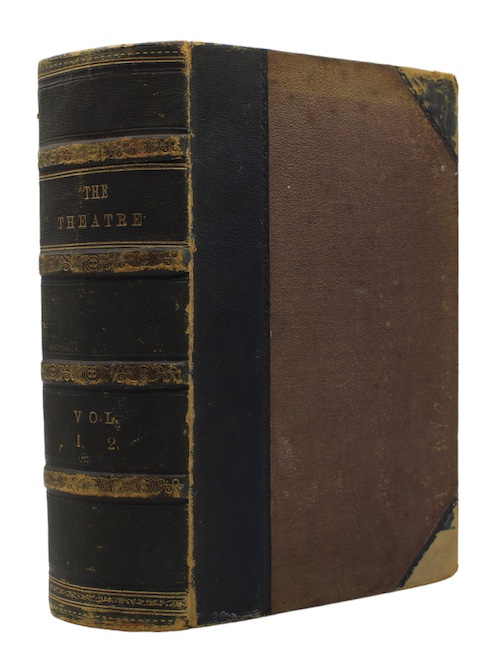
The Theatre. a monthly review and magazine. vol. I. new series. august, 1878, to january 1879 [- vol. II. new series. february to july 1879.]
[SCOTT, Clement] Two volumes bound as one. iv, 458; iv, 410pp. With photographic plates throughout. Contemporary black half-morocco, brown cloth boards, tooled and lettered in gilt, marbled edges. Extremities heavily rubbed. Marbled endpapers, scattered spotting. Inscribed to FFEP: 'To Larry, with my best wishes for many Happy Birthdays: + my love â" + gratitude for much. Bernard. 22:May:1949'. Clement Scott was an influential and controversial theatre critic and journalist who did much to shape the stage conventions we have today, including first night reviews and a quiet audience. He edited The Theatre from 1880-1889, having bought it from its founder Henry Irving. Inscribed for the date of Laurence Olivier's 42nd birthday, 22 May 1949, it's possible 'Bernard' is Bernard Braden, who was directed by Olivier in the London premier of A Streetcar Named Desire in October of that year. He starred as Mitch, alongside Vivien Leigh's Blanche. From the library of Laurence Olivier, to whom many books were gifted over the length of his illustrious, industrious, and enduring career as one of the most important figures of stage and screen in the 20th century. Size: Large 8vo- $196
- $196

Sister carrie
DREISER, Theodore [4], xvi, [1], 387pp, [1]. Original publisher's beige cloth-backed brown cloth boards, title label to spine lettered gilt, T.E.G., fore-edge untrimmed. Title label slightly chipped, corners bumped. Internally bright and clean except evidence of a bookplate removed from the front pastedown. Inscribed to the FFEP: 'For Laurence Olivier, With admiration and appreciation - Mrs Theodore Dreiser. Hollywood, August 29, 1950.' Signed and numbered by illustrator Reginald Marsh to the colophon. Bookseller label of Philip C. Duschnes, New York, to rear pastedown. Theodore Dreiser (1871-1945) was an American journalist and novelist, who's first novel, Sister Carrie, has been adapted for opera twice, film once, and ranked at number 33 on the Modern Library's list of the 100 best English-language novels of the 20th century. While the initial print run of a little over 1000 sold only 456 copies, this early naturalist novel remains an important study in social commentary. Inscribed by Dreiserâs widow, Helen, who had convinced Olivier to play the tragic figure of Hurstwood in the 1952 film adaptation opposite Jennifer Jones. The film was nominated for two Academy Awards in Costume Design and Art Direction. From the library of Laurence Olivier, to whom many books were gifted over the length of his illustrious, industrious, and enduring career as one of the most important figures of stage and screen in the 20th century. Size: Large 8vo Limited third edition, number 994 of 1500.- $261
- $261
![[Drop-head title:] To be given away! The Duke of Wellington](https://rarebookinsider.com/wp-content/uploads/2024/06/31895597718-600x460.jpg)
[Drop-head title:] To be given away! The Duke of Wellington, a whole-length portrait of the great warrior and statesman, representing him in his tent on the field of waterloo will be given to all purchasers of the new cheap london weekly newspaper, the magnet.
[DUKE OF WELLINGTON] Single leaf broadside. Mounted on later paper. A trifle creased. An apparently unrecorded broadside advertising readers of the weekly London newspaper The Magnet the opportunity to acquire, free of charge on consecutive Mondays, full-length portraits of the Duke of Wellington and William IV, to commemorative the anniversary of the Battle of Waterloo and the monarch's birthday respectively. Size: Dimensions 200 x 120 mm- $327
- $327

The Great Imposters
SPARROW, Gerald 192pp. Original publisher's brown cloth, lettered white. Extremities lightly scuffed. Internally bright and clean, RFEP unopened. With presentation inscription to FFEP: âTo Sir Laurence Olivier this little book about people who acted in real life, with the best wishes of the author â" Gerald Sparrow. 18/8/62.â Gerald Sparrow (1903â"1988) was a British lawyer, judge, and travel writer, who spent much of his career in Thailand. He retired to England, and authored various titles including his 'The Great.' series, wherein he recounted popular criminal cases along with those from his career. From the library of Laurence Olivier, to whom many books were gifted over the length of his illustrious, industrious, and enduring career as one of the most important figures of stage and screen in the 20th century. Size: 8vo- $65
- $65
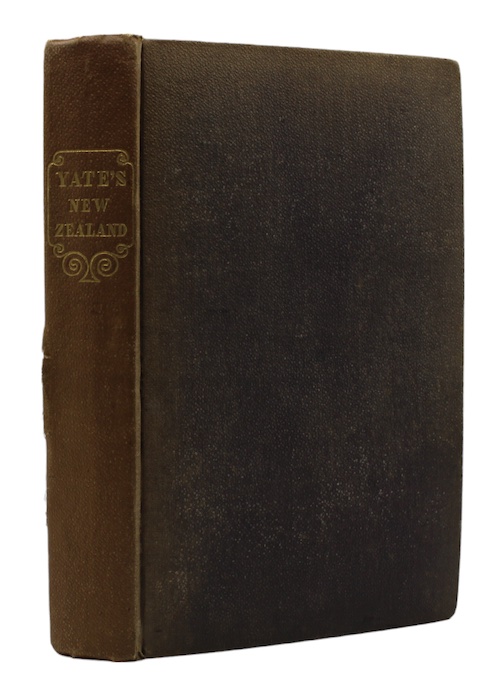
An account of new zealand; and of the formation and progress of the church missionary society’s mission in the northern island
YATE, Rev. William [8], 310pp, [10]. With an engraved portrait frontispiece, a further nine engraved plates, and an engraved folding map.Original publisher's brown cloth, lettered in gilt to spine, later recased, new endpapers. Lightly rubbed, lower joint split, spine sunned. Scattered spotting. The first edition of an account of seven years' missionary labour at Waimate, New Zealand. Size: 8vo- $196
- $196

Critical dissertations on the origin, antiquities, language, government, manners, and religion, of the ancient caledonians, their posterity the picts, and the british and irish scots
MACPHERSON, John xxiv, [2], 382pp. Contemporary gilt-tooled tan half-calf, marbled boards. Marbled edges. A trifle rubbed and marked, bumping to corners. Occasional marginal browning, else fine. Presentation copy, inscribed 'To Nathanial Wraall Esqr. from Sir John Macpherson, Brompton 10 August 1810' to head of title. A choice copy of the most significant work of Church of Scotland minister on Skye and antiquary John Macpherson (1713-1765), published posthumously, inscribed by the son of the author to the English travel writer, Sir Nathaniel William Wraxall (1751-1831). The author Sir John Macpherson (1744-1821) of Brompton Grove had sold his fatherâs manuscript of 'the production of the leisure hours in one of the remotest of the Scottish isles' in 1767, and wrote the dedication (to Charles Greville) which appears on the second leaf, before sailing for India, where he commenced a long and tumultuous association with the East India Company which included his sometime dismissal from the service by the Madras Council, his appointment as agent to Nawab Muhammed Ali, and his eventual succession as Governor- General of India on the resignation of Warren Hastings. His friendship with English travel writer and memoirist travel writer, Sir Nathaniel William Wraxall (1751-1831), himself sometime agent to Muhammad Ali, and to whom he inscribed this copy, is the source of much of his biography in relation to India. ESTC T96376. Size: Quarto- $1,960
- $1,960
Joe Miller’s jests or, the wits vade-mecum.: https://rarebookinsider.com/rare-books/joe-millers-jests-or-the-wits-vade-mecum/